Abstract
During laser-metal inert gas (MIG) hybrid welding, a large amount of welding status information is generated in droplet transfer, keyhole and molten pool. In this paper, austenitic stainless steel was adopted as an experimental object, with a dual high-speed camera system used to obtain real-time images of droplet transfer, keyhole and molten pool in a laser-MIG hybrid welding process. The changing regulation of a keyhole in three different penetration states (i.e., non-penetration, partial penetration and normal penetration) was analyzed by extracting the morphological characteristics of a keyhole shape, and combining the droplet transition information and the shape of the weld pool. Experimental results show that the proposed method could effectively reflect the variation characteristics of the keyhole, and the correlation among the keyhole characteristics, the droplet transfer information, the weld pool shape and the welding status, and provide a new perspective for online detection of the laser-MIG welding quality.
1. Introduction
Compared with laser welding [1,2,3] or arc welding [4,5,6], laser-arc hybrid [7,8,9] is more suitable for thick plate welding due to its advantages in penetration depth, welding speed, welding stability and weld forming quality. Hybrid welding has wide application prospects in industry because it does not need high assembly accuracy in the traditional laser welding process [10,11]. Recently, the existing research works on hybrid welding mainly focus on the mechanism of the hybrid welding process and the impact of welding parameters on welding quality [8,12]. Mechanistic studies include the analysis of droplet transition states, metal plasma, keyhole and molten pool flow states. Hybrid welding is composed of two different heat sources and its complex mechanism is easy to cause welding defects such as undercut, humping, spatter, porosity, etc. Therefore, it is necessary to monitor the welding process [13,14]. The welding process signal is combined with the pattern recognition algorithm and the intelligent control algorithm, which can realize the robust control of the penetration process by adjusting the welding process parameters [15]. The stability of the keyhole, molten pool, droplet transfer and plasma determine the welding quality and can also reflect the stability of the welding process [16]. At the same time, physical phenomena such as spatter and metal vapor are also directly related to the welding state.
Commonly used welding state detection technologies [17,18,19] include photoelectric sensors [20], high-speed cameras [21], spectrometers [22], X-ray transmission [23], infrared sensors [24,25], thermal sensors [26] and acoustics sensors [27]. Through the spectral analysis of the hybrid plasma plume and the high-speed photographic analysis of the laser-MIG hybrid welding process, Zhang [28] quantified the synergy effect between laser and arc. Zhu [29] used a high-speed camera to clarify the impact of magnetic intensity and frequency on arc shape and droplet transfer during alternating magnetic field-assisted laser-MIG welding. Tang [30] used dual high-speed cameras to study the formation mechanism of humping in thick plate welding and the method to avoid the formation of humping. Wang [31] proposed an analysis method to monitor the keyhole bottom of different penetration status in the laser-MIG hybrid welding process by a double high-speed camera system. The effect of the welding direction on the plasma and metal transfer of hybrid welding processes was investigated in [32], where the dynamics of the droplet transfer, plasma behavior and weld pool behavior were observed by using double high-speed camera systems, with an optical emission spectroscopy applied to analyze the plasma temperature and electron number density. Chandrasekhar [33] developed a prediction method using hybrid soft computing techniques for estimation of the weld bead width and penetration depth from the IR thermal image of the weld pool during autogenous tungsten inert gas (A-TIG) welding. Pal [34] identified the metal transfer sound modes from the arc sound analysis, along with the current and voltage sensor signal. Feng [35] analyzed the molten pool by establishing a numerical model of fluid flow, and the main characteristics of the molten pool flow pattern can be reflected. You [36] used multiple on-line measurements to detect the imperfection formation in laser welding. Among these methods, a more intuitive and effective monitoring method is to use a high-speed camera. In our previous report [37,38], we investigated the use of high-speed cameras to observe the droplet transfer and formation of root humping from the side horizontal direction for the prediction of weld formation. Our related previous works [37] found that the opening frequency of the keyhole bottom is higher and more stable in the welding process of a good weld. Visual characteristics, such as the area of the bottom molten pool SMB and the centroid coordinates of the bottom molten pool (xc, yc), which reflect the formation process of root humps, can be used as a basis for judging whether root hump has occurred. The main reason for root hump is the lack of heat input. When increasing the energy input of the laser or arc, root humps can be avoided.
In this work, dual high-speed cameras are used to capture the visual features during the welding process. First, the mechanism of the hybrid welding process is analyzed by combining the droplet transfer information and the variation of the characteristic parameters of the keyhole. The keyhole state is then used to study the changes in the welding state and analyze the weld formation. The main novelty of this paper can be succinctly summarized as follows: (1) Experiments show that the droplet transfer information, keyhole characteristics and changes in the shape of the molten pool are closely related to the welding state and weld formation, which can provide a new perspective for real-time state detection in the hybrid welding process. (2) The influence of characteristic changes of droplet transfer, keyhole and molten pool on welding quality in welding process monitoring was studied, with the reasons for such characteristic changes further analyzed. (3) The comparative study found that the stability of the Y-coordinate of the keyhole centroid Cy was significantly different under different welding conditions. The variance of the normalized characteristic signal was used to evaluate the fluctuation level of Cy. It was found that the variance of Cy in the case of root welding was approximately 45% higher than that in the case of normal penetration.
2. Experimental Setups
The experimental system included a high-power IPG YAG-4000 (IPG Laser GmbH, Burbach, Germany) fiber laser welding device, MIG arc welding machine (Panasonic YD-350/500GL4, Tangshan Panasonic Industrial Machinery Co., Ltd., Tangshan, China), protect gas device (Foshan Deli Messer Gas Co., Ltd., Foshan, China) and image acquisition system (5KF, Revealer, Hefei, China), as shown in Figure 1. The test material was 304 stainless steel and the size of the weldment was 200 mm × 60 mm × 4 mm. Lasers were continuous, while arcs were pulsed. The arc-leading form was adopted in the laser-MIG welding. The laser-wire distance was 2 mm. The shielding gas consisted of 98% Ar and 2% CO2, with a gas flow rate of 30 L/min. The welding speed was 1.4 m/min and the defocus amount was 0 mm.
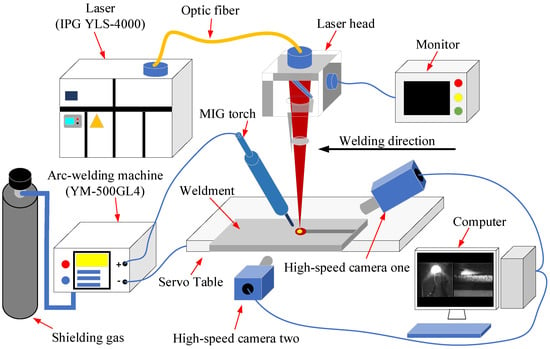
Figure 1.
Device system diagram of laser-MIG hybrid welding.
In order to analyze the transient characteristics of metal vapor, arc, droplet transfer information and keyhole morphology, a high-speed camera equipped with an 808 nm filter ( Shenzhen Taizhu Technology Co., Ltd., Shenzhen, China) was installed above the weld side, with the lens 300 mm away from the welding plate and 30 degrees from the horizontal direction; another high-speed camera is in the same horizontal plane as the welding plate. And its shooting direction is perpendicular to the welding direction. In addition, the weld area was covered with an auxiliary laser with a wavelength of 808 nm to remove interference. The acquisition speed of the high-speed camera in the experiment was 2000 fps. The calibration image of the captured field of view is shown in Figure 2, with the area in the red box being the content of observation and recording.

Figure 2.
The calibration image of the captured field of view for hybrid welding. (a) The calibration image from camera one. (b) The calibration image from camera two.
3. Welding Visual Features Extraction
In the experiment, a part of the welding process image was intercepted for analysis, with the characteristics variation of arc, droplet and keyhole selected as the research object. Intense arcing, spatters and flow of the molten pool can affect the extraction of keyhole features. Therefore, the arc area SArc was firstly obtained by thresholding segmentation, morphological operations and other methods. The state of the droplet transfer could be judged by SArc. If it is in the state of arcing, the keyhole feature corresponding to this frame could be replaced by the feature of the previous moment because the strong arc light has covered the keyhole. If it is in the non-arcing state, the keyhole feature on the image at this time can be calculated. Figure 3 shows the image processing flow and the final results of keyhole feature extraction. The region of interest (ROI) was selected from the original image and was then segmented by binarization. The morphological opening operation was used to remove the noise, with the method based on the maximum connected domain used to find the maximum area. Thereby, the keyhole region was obtained and five keyhole features were extracted from this area: the keyhole area SKeyhole, that is, the sum of the pixel points in the region of the keyhole; the centroid coordinates of the keyhole region (Cx, Cy); the perimeter (P) and width (W) of the keyhole.

Figure 3.
Image process of keyhole features extraction.
4. Results and Discussion
The welding process of three different penetration states of laser-MIG hybrid welding will be discussed. Bead-on-plate welding was adopted in the experiment. The welding parameters are shown in Table 1. Figure 4 shows the schematic diagram of Laser-MIG hybrid welding. The arc preheats the weldment, which improve the absorption rate of laser energy. Arc plasma can dilute laser plasma, reducing the effect of reverse bremsstrahlung absorption. The keyhole is formed under the action of the laser. Droplet transfer will promote the fluidity of the molten pool and affect the stability of the keyhole. If the keyhole is unstable, such as the collapse of the keyhole, it is easy to cause weld defects. The penetration depth of the weld is mainly determined by the laser power, with the width of the weld determined by the current and voltage of the arc.

Table 1.
Experimental conditions of laser-MIG hybrid welding.
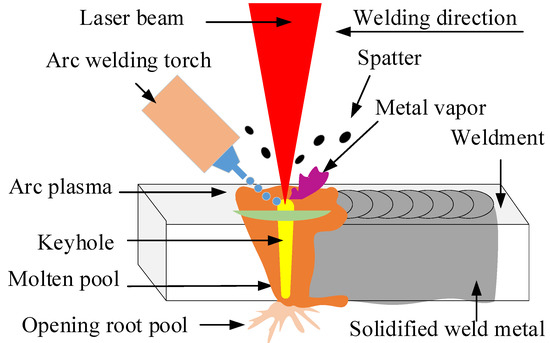
Figure 4.
Schematic diagram of Laser-MIG hybrid welding.
When the current is 150 A and the voltage is 18 V (No. 1 and No. 3), globular transfer appears. According to the image captured from camera two during non-penetration welding (Figure 5), the bottom of the welding plate remains unchanged. The keyhole does not penetrate to the bottom of the welding plate due to the low laser power, so the molten pool liquid does not flow to the bottom of the welding plate, and the accumulation height of the molten pool above the plate is higher than that of the other two experiments. The weld height of the No. 1 experiment is also higher than that of the No. 3 experiment. The falling droplet pushes the liquid level of the molten pool to flow towards the welding direction, making the liquid level fluctuate. It can be seen from Figure 6 that the centroid coordinate of the keyhole is relatively stable, with the keyhole area SKeyhole changing periodically. The trend of the perimeter and width of the keyhole is consistent with that of the keyhole area.
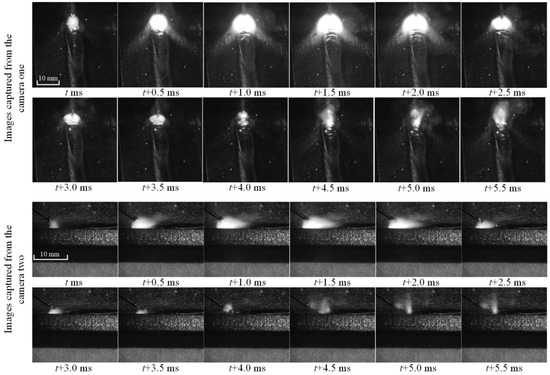
Figure 5.
Visual phenomena of non-penetration (No. 1) in laser-MIG hybrid welding.
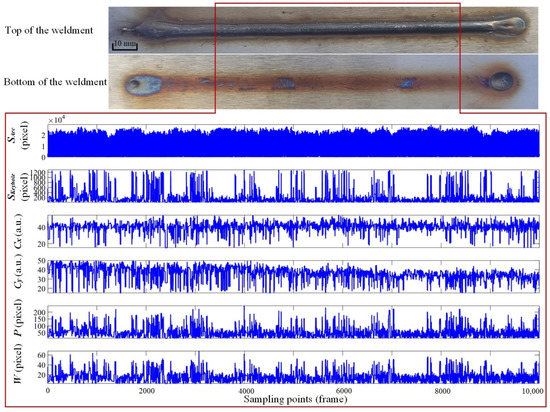
Figure 6.
Visual features of non-penetration (No. 1) in the laser-MIG hybrid welding process.
According to the results of a large number of experiments, it was found that for 4 mm thick stainless steel, root humping is produced under the conditions of a welding speed of 1.4 m/min and a laser power of 2.5 kW, due to insufficient heat input. According to the welding process images of partial penetration welding (Figure 7), it can be seen that the liquid level of the molten pool rotates counterclockwise under the action of the droplet and the arc pressure, which increases the instability of the keyhole. When the current is 120 A and the voltage is 16 V, the form of droplet transfer is short-circuiting transfer. It is noticeable from Figure 7 that short-circuit transition occurs at t + 1.5 ms and t + 2.0 ms, with a “liquid metal bridge” formed. At t + 2.5 ms and t + 3.0 ms, under the action of the surface tension of the molten pool, the electromagnetic shrinkage force and the gravity, it breaks at the neck down and produces droplet explosion, completing the process of droplet transfer. Droplet explosion produces many spatters, so there is obviously more spatter on the surface of the weld.
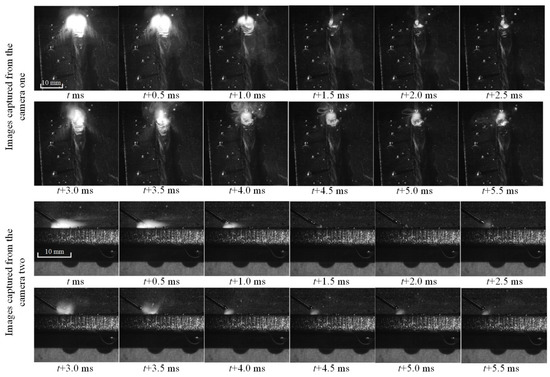
Figure 7.
Visual phenomena of partial penetration (No. 2) in laser-MIG hybrid welding.
As can be seen from Figure 8, the Y-coordinate of the centroid of the keyhole submits the wave to rise and fall. The analysis shows that the peak of the Y-coordinate of the centroid corresponds to an image with a large keyhole area, with the keyhole located in the upper part of the ROI; the trough of the Y-coordinate of the centroid corresponds to an image with a small keyhole area, with the keyhole located in the lower part of the ROI. It can be inferred that due to the unstable droplet transfer, the fluctuation of the keyhole is large, and the molten liquid cannot flow to the bottom of the molten pool smoothly, which may be one reason for root humping. It can be seen from Figure 7 that the shadow of two continuous molten humps appears at the bottom of the weldment, which will form root humping.
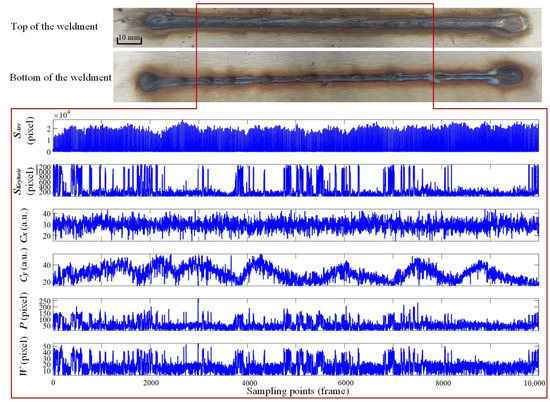
Figure 8.
Visual features of partial penetration (No. 2) in the laser-MIG hybrid welding process.
It can be easily observed from Figure 7 and Figure 8 that the Y-coordinate of the centroid of the keyhole Cy has the most significant difference, with the Cy shown in Figure 8 displaying obvious fluctuation characteristics, which may be due to the unstable molten pool level caused by the short-circuit transition. We use the variance to measure how volatile this characteristic timing signal is. Let . Firstly, normalize the characteristic signal, i.e., , and then calculate the variance of this characteristic in the two cases of normal penetration (No. 3) and root humping (No. 2): , where is the average value of the characteristic signal (N is the total number of images; n = 1, 2, ..., N). By calculation, the results and are obtained, which means that the variance of Cy in the case of root humping (No. 2) is approximately 45% higher than that of normal penetration (No. 3).
Under the same experimental conditions, five experiments were performed for each group of welding process parameters, with the same weld types obtained. There are slight differences in visual characteristics, but the overall regulation is consistent. The analytical results obtained using the comparative method based on the variance of Cy are consistent.
The formation mechanism of weld humping is further studied with the aid of photographed welding process images, with the schematic diagram of molten metal flow during root humping formation shown in Figure 9. Figure 9 shows that the area ① is not welded. The area ② represents the molten metal, which is the form of metal under the action of a high-energy heat source. The area that is cooled and resolidified after welding is shown in ③. The flow direction and the distribution of various forces are shown in Figure 9. The main forces include the gravity of the molten metal, surface tension, metal vapor and laser vapor reactions. It can be seen that the balance of surface tension and gravity is a key factor in the formation of the hump. The faster the molten hump at the bottom of the welding plate reflows to the central area of the molten pool, the less molten metal will be deposited on the bottom of the welded plate. In summary, the smaller the gravity, the more favorable it is to suppress the formation of root humping [39]. Hence, one way to solve the root humping problem is to speed up the root pool flow through high-speed welding [23].
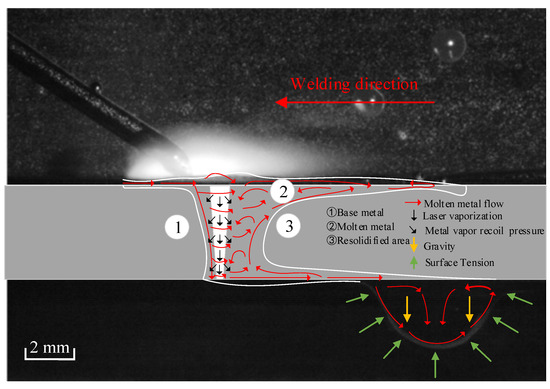
Figure 9.
Schematic diagram of molten metal flow during root humping formation.
Some characteristics such as the shape of the tail of the weld pool can be used to deduce the formation of the weld. The tail of the weld pool in the partial penetration welding experiment (No. 2) is sharp and narrow and has a triangular shape, as shown in Figure 7. The tail of the melt pool in the normal penetration welding experiment (No. 3) is wider and square, as shown in Figure 10. The shape of the tails of both weld pools is consistent with the formation of their final welds. The normal penetration weld is full, while the partial penetration weld is not full enough, and even undercuts will appear. The current and voltage of the No. 3 experiment are the same as those of the No. 1 experiment, but the weld height of the No. 3 experiment is not as high as that of the No. 1 experiment because the higher laser power adopted by the No. 3 experiment penetrates the welding plate, which makes the molten liquid flow to the bottom of the welding plate. It can be seen from the side video of the normal penetration welding process that the bottom of the keyhole will be opened and closed regularly, with the molten liquid flowing to the bottom of the weldment evenly, so that the top and bottom of the weld are well formed. It is noticeable from the time series curve of Cx and Cy in Figure 11 that the keyhole is relatively stable. Compared with the time series curve of SKeyhole of the No. 1 and No. 2 welding experiments, that of the No. 3 welding experiment is larger because of the higher laser power.
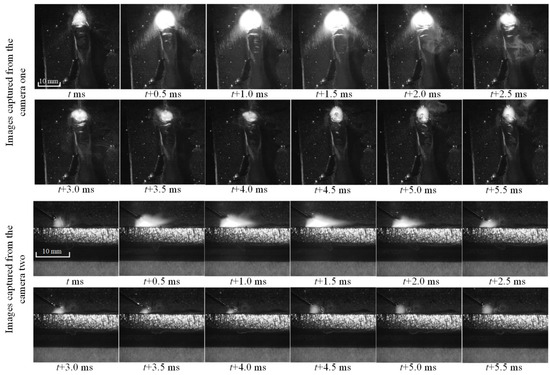
Figure 10.
Visual phenomena of normal penetration (No. 3) in laser-MIG hybrid welding.
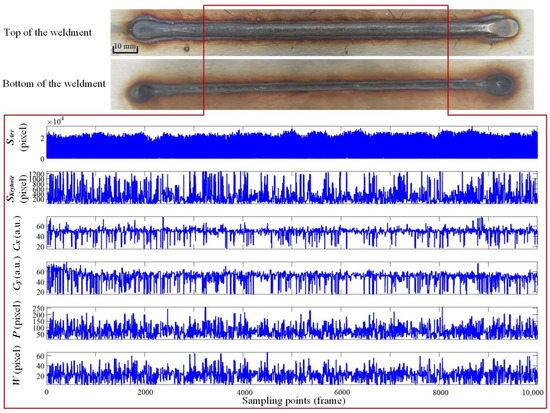
Figure 11.
Visual features of normal penetration (No. 3) in the laser-MIG hybrid welding process.
5. Conclusions
The changing regulation of the keyhole in three different penetration states is analyzed in this paper. The physical phenomena in the laser-MIG hybrid welding were photographed by the dual high-speed system, with the keyhole characteristics extracted by the image processing algorithm. When the laser power is sufficient to weld through the welding plate, the molten liquid will flow to the bottom of the welding plate, so that the height of the upper welding seam is not as high as that of the non-penetration weldment. According to a large number of experiments, it was found that for a 4 mm thick stainless-steel plate, under the conditions of a welding speed of 1.4 m/min and a laser power of 2.5 kW, root humping will be produced due to insufficient heat input. The formation mechanism of root humping and the measures to avoid the phenomena are discussed. At a current of 120 A and a voltage of 16 V, short-circuiting transfer occurs. Spatters are produced when the droplets explode. Due to the unstable droplet transfer, the fluctuation of the keyhole is large and the molten liquid cannot flow to the bottom of the molten pool smoothly, which may be one reason for the humping. The formation of the weld can be inferred from the shape of the tail of the weld pool. When the keyhole is in a stable state, the bottom of the keyhole will open and close regularly, and the molten liquid can flow to the bottom of the weld evenly, so the top and bottom of the weld are well formed. The comparative study found that the stability of the Y-coordinate of the keyhole centroid Cy was significantly different under different welding conditions. The variance of the normalized characteristic signal was used to evaluate the fluctuation level of Cy. It was found that the variance of Cy in the case of root humping was approximately 45% higher than that for normal penetration. The results show that the proposed analysis method can be used to monitor the state of the laser-MIG hybrid welding process.
Future work can be mainly performed from two aspects: on the one hand, combining visual sensing technology with photoelectric sensing technology which is more suitable for industrial applications, to monitor and analyze the welding process, promoting the transformation of academic research results into practical industrial applications. On the other hand, according to the detection signal of the welding process, a process stability control system that adjusts welding parameters in real time can be constructed to realize adaptive welding process stability adjustment, which can improve welding efficiency and quality.
Author Contributions
Conceptualization, X.G.; data curation, X.F., Y.H. and Y.Z.; funding acquisition, X.G.; investigation, X.F. and Y.H.; methodology, X.F., X.G. and Y.Z.; project administration, X.G.; resources, X.G.; supervision, X.F., Y.H., Y.Z. and X.G.; visualization, X.F.; writing—original draft preparation, X.F. and X.G.; writing—review and editing, X.G. All authors have read and agreed to the published version of the manuscript.
Funding
This work was partly supported by the Guangzhou Municipal Special Fund Project for Scientific and Technological Innovation and Development (202002020068).
Institutional Review Board Statement
Not applicable.
Informed Consent Statement
Not applicable.
Data Availability Statement
Not applicable.
Conflicts of Interest
The authors declare no conflict of interest.
References
- Huang, Y.; Gao, X.; Ma, B.; Zhang, Y. Interface formation and bonding mechanisms of laser welding of PMMA plastic and 304 austenic stainless steel. Metals 2021, 11, 1495. [Google Scholar] [CrossRef]
- Zhang, Y.; Han, S.W.; Cheon, J.; Na, S.J.; Gao, X. Effect of joint gap on bead formation in laser butt welding of stainless steel. J. Manuf. Process. 2017, 249, 274–284. [Google Scholar] [CrossRef]
- Oliveira, J.P.; Shamsolhodaei, A.; Shen, J.; Lopes, J.G.; Gonçalves, R.M.; Ferraz, M.; Piçarra, L.; Zeng, Z.; Schell, N.; Zhou, N.; et al. Improving the ductility in laser welded joints of CoCrFeMnNi high entropy alloy to 316 stainless steel. Mater. Design 2022, 219, 110717. [Google Scholar] [CrossRef]
- Gao, X.; Ding, D.; Bai, T.; Katayama, S. Weld Pool Image Centroid Algorithm for Seam Tracking Vision Model in Arc Welding Process. IET Image Process. 2011, 5, 410–419. [Google Scholar] [CrossRef]
- Perić, M.; Garašić, I.; Gubeljak, N.; Tonković, Z.; Nižetić, S.; Osman, K. Numerical Simulation and Experimental Measurement of Residual Stresses in a Thick-Walled Buried-Arc Welded Pipe Structure. Metals 2022, 12, 1102. [Google Scholar] [CrossRef]
- Martin, A.C.; Oliveira, J.P.; Fink, C. Elemental effects on weld cracking susceptibility in AlxCoCrCuyFeNi high-entropy alloy. Metall. Mater. Trans. A 2020, 51, 778–787. [Google Scholar] [CrossRef]
- Lee, C.M.; Woo, W.S.; Baek, J.T.; Kim, E.J. Laser and arc manufacturing processes: A review. Int. J. Precis. Eng. Man. 2016, 17, 973–985. [Google Scholar] [CrossRef]
- Chen, M.; Li, X.; Liu, L. Effect of electric field on interaction between laser and arc plasma in laser-arc hybrid welding. IEEE T. Plasma Sci. 2012, 40, 2045–2050. [Google Scholar] [CrossRef]
- Song, G.; Wang, Z.; Liu, Z.; Liu, L. Effect of partial rolling on the microstructure and mechanical properties of laser-TIG hybrid welded joints of 7075-T6 aluminum alloy. Int. J. Adv. Manuf. Technol. 2022, 121, 589–599. [Google Scholar] [CrossRef]
- Bunaziv, I.; Akselsen, O.M.; Salminen, A.; Unt, A. Fiber laser-MIG hybrid welding of 5 mm 5083 aluminum alloy. J. Mater. Process. Technol. 2016, 233, 107–114. [Google Scholar] [CrossRef]
- Bagger, C.; Olsen, F.O. Review of laser hybrid welding. J. Laser Appl. 2004, 17, 2–14. [Google Scholar] [CrossRef]
- Liu, S.; Chen, S.; Wang, Q.; Li, Y.; Zhang, H.; Ding, H. Analysis of plasma characteristics and conductive mechanism of laser assisted pulsed arc welding. Opt. Laser Eng. 2017, 92, 39–47. [Google Scholar] [CrossRef]
- Chen, J.; Wang, T.; Gao, X.; Li, W. Real-time monitoring of high-power disk laser welding based on support vector machine. Comput. Ind. 2018, 94, 75–81. [Google Scholar] [CrossRef]
- Gao, X.; Zhang, Y. Monitoring of welding status by molten pool morphology during high-power disk laser welding. Optik 2015, 126, 1797–1802. [Google Scholar] [CrossRef]
- Liu, Y.; Zhang, W.; Zhang, Y. Dynamic neuro-fuzzy-based human intelligence modeling and control in GTAW. IEEE T. Autom. Sci. Eng. 2013, 12, 324–335. [Google Scholar] [CrossRef]
- Wang, T.; Gao, X.; Katayama, S.; Jin, X. Study of dynamic features of surface plasma in high-power disk laser welding. Plasma Sci. Technol. 2012, 14, 245–251. [Google Scholar] [CrossRef]
- Fan, X.; Gao, X.; Liu, G.; Ma, N.; Zhang, Y. Research and prospect of welding monitoring technology based on machine vision. Int. J. Adv. Manuf. Technol. 2021, 115, 3365–3391. [Google Scholar] [CrossRef]
- Wu, D.; Zhang, P.; Yu, Z.; Zhang, H.; Chen, H.; Tian, Y. Progress and perspectives of in-situ optical monitoring in laser beam welding: Sensing, characterization and modeling. J. Manuf. Process. 2022, 75, 767–791. [Google Scholar] [CrossRef]
- Kong, L.; Peng, X.; Chen, Y.; Wang, P.; Xu, M. Multi-sensor measurement and data fusion technology for manufacturing process monitoring: A literature review. Int. J. Extreme Manuf. 2020, 2, 022001. [Google Scholar] [CrossRef]
- Sforza, P.; Blasiis, D. On-line optical monitoring system for arc welding. NDT E Int. 2002, 35, 37–43. [Google Scholar] [CrossRef]
- Chen, M.; Xin, L.; Zhou, Q.; He, L.; Wu, F. Effect of laser pulse on alternative current arc discharge during laser-arc hybrid welding of magnesium alloy. Opt. Laser Eng. 2018, 100, 208–215. [Google Scholar] [CrossRef]
- Chen, Y.; Chen, B.; Yao, Y.; Tan, C.; Feng, J. A spectroscopic method based on support vector machine and artificial neural network for fiber laser welding defects detection and classification. NDT E Int. 2019, 108, 102176. [Google Scholar] [CrossRef]
- Pan, Q.; Mizutani, M.; Kawahito, Y.; Katayama, S. High power disk laser-metal active gas arc hybrid welding of thick high tensile strength steel plates. J. Laser Appl. 2016, 28, 012004. [Google Scholar] [CrossRef]
- Gao, X.; You, D.; Katayama, S. Infrared image recognition for seam tracking monitoring during fiber laser welding. Mechatronics 2012, 22, 370–380. [Google Scholar] [CrossRef]
- Chokkalingham, S.; Chandrasekhar, N.; Vasudevan, M. Predicting the depth of penetration and weld bead width from the infra red thermal image of the weld pool using artificial neural network modeling. J. Intell. Manuf. 2012, 23, 1995–2001. [Google Scholar] [CrossRef]
- Sreedhar, U.; Krishnamurthy, C.V.; Balasubramaniam, K.; Raghupathyc, V.D.; Ravisankarc, S. Automatic defect identification using thermal image analysis for online weld quality monitoring. J. Mater. Process. Tech. 2012, 212, 1557–1566. [Google Scholar] [CrossRef]
- Pal, K.; Pal, S.K. Monitoring of weld penetration using arc acoustics. Mater. Manuf. Process. 2011, 26, 684–693. [Google Scholar] [CrossRef]
- Zhang, C.; Gao, M.; Zeng, X. Influences of synergy effect between laser and arc on laser-arc hybrid welding of aluminum alloys. Opt. Laser Technol. 2019, 120, 105766. [Google Scholar] [CrossRef]
- Zhu, Z.; Ma, X.; Wang, C.; Mi, G. Modification of droplet morphology and arc oscillation by magnetic field in laser-MIG hybrid welding. Opt. Laser Eng. 2020, 131, 106138. [Google Scholar] [CrossRef]
- Tang, G.; Zhao, X.; Li, R.; Liang, Y.; Jiang, Y.; Chen, H. The effect of arc position on laser-arc hybrid welding of 12-mm-thick high strength bainitic steel. Opt. Laser Technol. 2020, 121, 105780. [Google Scholar] [CrossRef]
- Wang, L.; Gao, X.; Chen, Z. Status analysis of keyhole bottom in laser-MAG hybrid welding process. Opt. express 2018, 26, 347–355. [Google Scholar] [CrossRef] [PubMed]
- Zhang, W.; Hua, X.; Liao, W.; Li, F.; Wang, M. The effect of the welding direction on the plasma and metal transfer behavior of CO2 laser+ GMAW-P hybrid welding processes. Opt. Laser Eng. 2014, 58, 102–108. [Google Scholar] [CrossRef]
- Chandrasekhar, N.; Vasudevan, M.; Bhaduri, A.K.; Jayakumar, T. Intelligent modeling for estimating weld bead width and depth of penetration from infra-red thermal images of the weld pool. J. Intell. Manuf. 2015, 26, 59–71. [Google Scholar] [CrossRef]
- Pal, K.; Bhattacharya, S.; Pal, S.K. Investigation on arc sound and metal transfer modes for on-line monitoring in pulsed gas metal arc welding. J. Mater. Process. Technol. 2010, 210, 1397–1410. [Google Scholar] [CrossRef]
- Feng, Y.; Gao, X.; Zhang, Y.; Peng, C.; Gui, X.; Sun, Y.; Xiao, X. Simulation and experiment for dynamics of laser welding keyhole and molten pool at different penetration status. Int. J. Adv. Manuf. Technol. 2021, 112, 2301–2312. [Google Scholar] [CrossRef]
- You, D.; Gao, X.; Katayama, S. Detection of imperfection formation in disk laser welding using multiple on-line measurements. J. Mater. Process. Technol. 2015, 219, 209–220. [Google Scholar] [CrossRef]
- Fan, X.; Wang, C.; Zhang, N.; Zhang, Y.; Huang, Y.; Gao, X. Evaluation of welding process stability and weld formation during laser-MIG hybrid welding. In Proceedings of the 2021 7th International Conference on Mechanical Engineering, Materials and Automation Technology (MMEAT 2021), Dali, China, 18–20 June 2021. [Google Scholar]
- Fan, X.; Gao, X.; Zhang, N.; Ye, G.; Liu, G.; Zhang, Y. Monitoring of 304 austenitic stainless-steel laser-MIG hybrid welding process based on EMD-SVM. J. Manuf. Process. 2022, 73, 736–747. [Google Scholar] [CrossRef]
- Frostevarg, J. Factors affecting weld root morphology in laser keyhole welding. Opt. Laser Eng. 2018, 101, 89–98. [Google Scholar] [CrossRef]
Publisher’s Note: MDPI stays neutral with regard to jurisdictional claims in published maps and institutional affiliations. |
© 2022 by the authors. Licensee MDPI, Basel, Switzerland. This article is an open access article distributed under the terms and conditions of the Creative Commons Attribution (CC BY) license (https://creativecommons.org/licenses/by/4.0/).